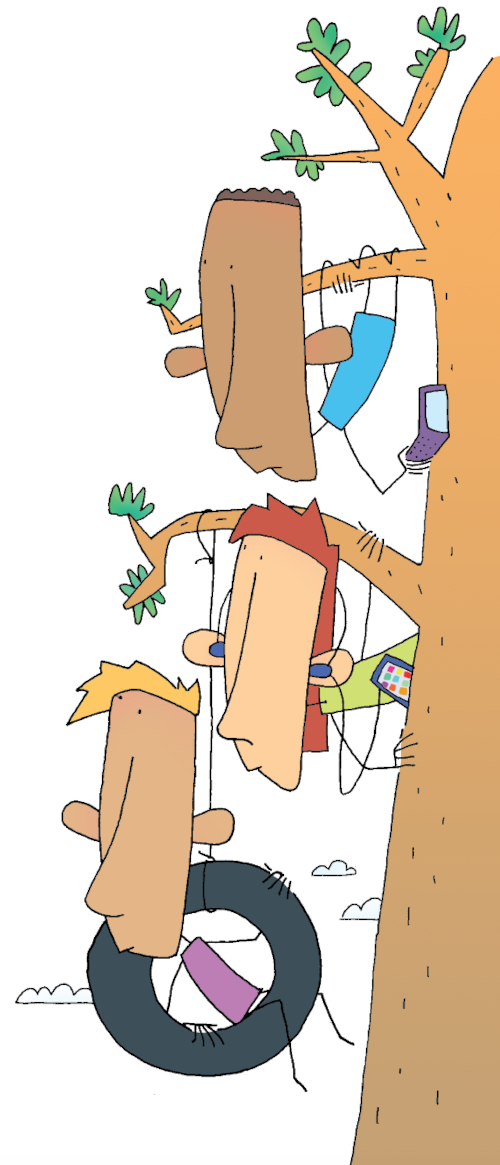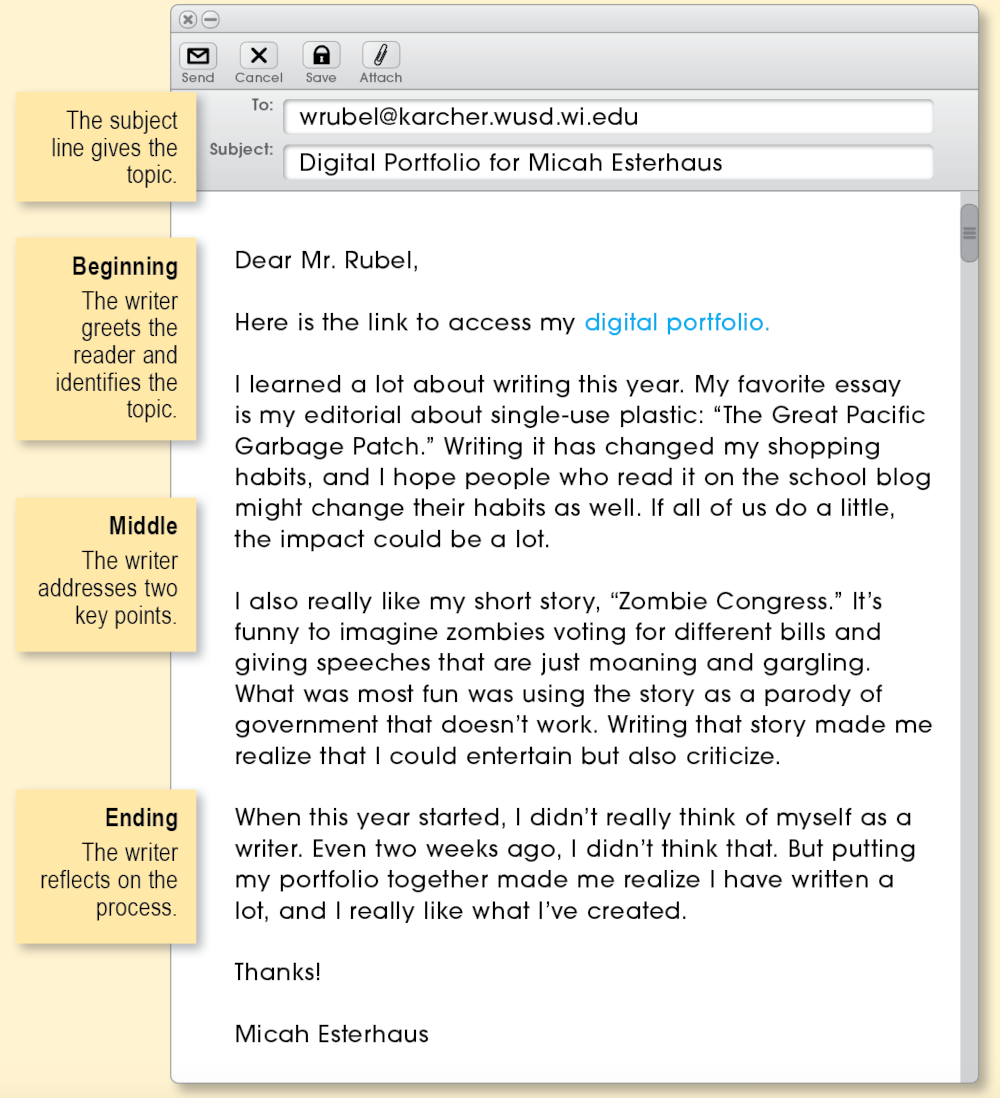WOC 139

Page 139
Writing Emails and Blog Posts
How do you “hang out” with friends? Are you physically together, or do you connect via text or video chat? You probably communicate in many different ways throughout a day.
When you need to communicate with others, you can use more formal types of writing. An email lets you speak to teachers, employers, and other adults. A blog post lets you communicate with anyone who has Internet access.
In this chapter, you’ll find an example email and blog post along with guidelines for creating your own. You can communicate awhile with adults, and then go back to hanging out with your friends.
What’s Ahead
WOC 140
Page 140
Email lets you communicate important information with adults and friends. Student Micah Esterhaus wrote the following email about her digital portfolio.
Email Message

WOC 141
Page 141
Writing Guidelines
You can use email to communicate important information and provide attachments and links. Email creates a time-stamped record, so you should make sure your emails are clear, correct, and complete.
Prewriting ■ Gathering Ideas
- Figure out what you need to say and why.
- Then gather all the details you need to include.
Writing ■ Drafting the Message
Beginning ■ Write a subject line that provides the topic at a glance. (Leave the “To” line blank until you have thoroughly proofread your work.) At the beginning of your message, greet the reader and state your reason for writing.
Middle ■ Provide all the details that the reader needs, carefully organized and clearly stated.
Ending ■ Call for any follow-up action, sum up the message, and provide a polite closing, including your name.
Ending ■ Call for any follow-up action, sum up the message, and provide a polite closing, including your name.
Revising ■ and Editing ■ Improving Your Message
Check your email before sending it. Although an email can be informal, it shouldn’t be messy, wordy, or full of errors. Use this checklist.
_____ Is my message complete—providing all the information needed so that I don’t have to send another message?
_____ Is my message clear—written in short paragraphs?
_____ Is my email correct—have I checked for spelling, punctuation, and other errors?
_____ Is my message accurate—from the reader’s email address to each fact or detail I’ve provided?
WOC 142
Page 142
Blog Post
In the following blog post, a student shares his discoveries about water-bears, tiny creatures with amazing survival skills. His post is meant to inform and entertain.
Blog Post

A title and photo spark interest. Toughest Bear
ANYWHERE
Beginning:
A creative introduction grabs attention. As bears go, you might think that Kodiak grizzlies are the toughest, or maybe polar bears. But they cannot survive at the bottom of the ocean or in the vacuum of space. The toughest “bear” is the water-bear, or tardigrade.
These tiny creatures have survived each of the earth’s five mass extinctions. They live on mountaintops and in deep-sea trenches, in deserts and freshwater lakes. They can dehydrate and survive for 30 years in the vacuum of space only to get rehydrated and start crawling again.
Middle:
Many fascinating details explain the topic. Of course, water-bears aren’t bears at all but tiny relatives of arthropods like insects and spiders. At only half a millimeter in length, they are hard to spot, but they are just about everywhere. Four pairs of legs with claws let them cling to whatever surface they are bumbling on. They have round mouths with stylets for piercing and breaking down the algae and tiny animals they eat. The mouth leads to an esophagus and intestine, which take up most of the bulbous body. The outside of the body is covered in chiton, which it molts occasionally. Tardigrades do have brains, but they don’t have lungs. Their skins take in oxygen directly from the air.
Tardigrades may actually be the first earthlings to colonize another planet. The asteroid that killed the dinosaurs hurled huge amounts of material into space—earth and water that was full of tardigrades. If any of that material fell as asteroids onto Mars, the impact could melt frozen ground water and reawaken the tardigrades. As long as tardigrades can find a source of water, they can survive. What would they eat on Mars? Well, some tardigrades eat each other.
Ending:
The writer reviews the blog post, with a final thought. Tardigrades really are the toughest bears anywhere—whether in the Mariana Trench or on the top of Mount Everest, or possibly in a Martian crater with a small frozen sea. If tardigrades made it that far, they’d actually be “Martian polar water-bears”!
WOC 143
Page 143
Writing Guidelines
A blog lets you communicate with your teachers and classmates about important topics. When you write a blog entry, tag it with subjects so people can find it. When you respond to someone else’s blog post, always be polite and clear in your comments.
Prewriting ■ Choosing a Topic
- Use the PAST strategy to analyze the writing situation. (See page 30.)
- Select a topic and research it as needed.
- Form a focus (thesis) and organize supporting details.
Writing ■ Creating the First Draft
Beginning ■ Introduce your topic and focus in an interesting way to get your reader’s attention.
Middle ■ Explain or support your focus with specific details. Address main points in separate paragraphs.
Ending ■ Conclude your post by restating your focus, giving a final thought about it, and/or welcoming readers to comment on your ideas.
Title ■ Create an interesting title as a lead-in to the post.
Graphics ■ Consider including a graphic to enhance your post.
Links ■ If appropriate, include links to related Web pages.
Ending ■ Conclude your post by restating your focus, giving a final thought about it, and/or welcoming readers to comment on your ideas.
Title ■ Create an interesting title as a lead-in to the post.
Graphics ■ Consider including a graphic to enhance your post.
Links ■ If appropriate, include links to related Web pages.
Graphics ■ Consider including a graphic to enhance your post.
Links ■ If appropriate, include links to related Web pages.
Revising ■ and Editing ■ Improving Your Writing
Check your work before posting. Your writing may be informal in style, but it still must be clear, interesting, and free of careless errors. Use this checklist.
_____ Is my post accurate—from the first line to the final thought?
_____ Is my post complete—offering what readers need to know?
_____ Is my post clear—shared in easy-to-follow sentences and paragraphs as well as in bulleted lists?
_____ Is my post correct—free of spelling, punctuation, and grammar errors?